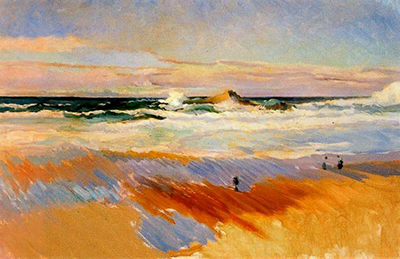 Buy Art Prints Now
Buy Art Prints Nowfrom Amazon
* As an Amazon Associate, and partner with Google Adsense and Ezoic, I earn from qualifying purchases.
This loosely constructed piece could easily have been some sort of study and Sorolla does not implement too much detail within it. Much of the detail is suggested at rather than delivered in a precise, photo-realistic form as one might find elsewhere in his career.
The brushwork used here is quick and long, helping to produce a feeling of perspective as we look across the beach in front of us. Could the artist have been perched on a pathway just above the beach? The figures are also unusually small by the standards of most of his paintings, giving a very different feeling to his other beach-based paintings. There are several rocks in the background which take the brunt of the waves, but also provide some aesthetic interest. The beach is covered with a small palette of orange, blue and brown, which gives us the impression of the dry and wet parts of it. The sky is perhaps the most complete element of the painting, featuring beautifully crafted clouds along the bottom half, with touches of pink tones contrasting with other parts of the painting.
Beaches would be used many times by Sorolla and he exhausted pretty much every different variation of this theme by the end of his career. The artist discovered that his love of bright colour would go hand in hand with the light-saturated Spanish coast. During his era, there was also an abudnance of activity along these sociable stretches of sand in which a wide section of society would come to enjoy leisure time, or to work as in the case of the many fishermen. Sorolla would go on to specialise in portraits of children and mothers bathing within this environment but also learnt how to accurately depict the different types of vessels that would be found on or close to the shore. His previous dalliances with social realism also came into play here as he became fascinated by how local people would call upon the help of their cattle in order to drag boats in and out of the water on a daily basis. The overall body of work from this genre would become the most famous part of Sorolla's whole career.
Sorolla is today considered by most to have been one of the most important Spanish artists of all time. He would specifically provide an extra strand to the European Impressionist movement, which was, of course, mainly based in France. He was able to take the elements of the style and combine it with some of the unique qualities of Spain to create some truly majestic work. He also covered a wide variety of genres within his oeuvre, even though he remains most famous for his beach scenes today. Sorolla spent many years developing his style and technical ability, and initially would be more academic in approach, with quite the same levels of expression which came about later in life once his confidence and ambitious nature had started to develop. This can be seen in the careers of many other famous artists, where they slowly reveal their true nature having been restricted by their artistic education for the earlier part of their lives. In terms of beach scenes, another highly memorable artwork worth studying would be Fishing for Oysters at Cancale by John Singer Sargent, and this famous painter would become friends with Sorolla.



